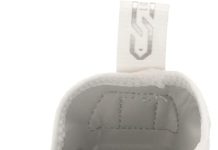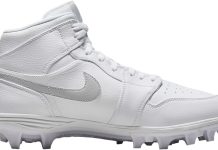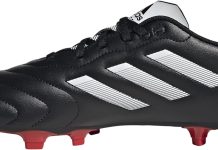Lace-up your shoes and ready your cleats because we’re about to uncover the playing field rules regarding metal versus plastic.
Have you ever wondered why some athletes don sleek metal cleats while others swear by their trusty plastic ones? We’ve got you covered.
In this article, we will take a closer look at the different sports that embrace these two types of cleats, discovering the nuances that make each sport unique and the factors determining which type of cleat is the perfect fit.
So, put your best foot forward and join us as we explore the world of metal and plastic cleats in various sports.
Baseball
Baseball is a beloved sport that has captured the hearts of fans worldwide. There are several levels of baseball, each with its own set of rules and regulations. Let’s dive into the different categories and explore what makes each unique.
Review contents
Major League Baseball
When it comes to professional baseball, Major League Baseball (MLB) reigns supreme. MLB comprises 30 teams, each vying for the coveted title of World Series Champions. The players in the MLB showcase their exceptional skills in hitting, pitching, and fielding. In terms of cleats, both metal and plastic cleats are allowed in MLB games. Many players prefer metal cleats because they provide superior traction, especially on grass and dirt surfaces.
High School and College
Baseball at the high school and college level is popular among students and serves as a stepping stone for aspiring professional players. In both high school and college baseball, metal cleats are commonly used. The durability and enhanced grip of metal cleats make them a preferred choice for athletes competing at these levels. However, some leagues and schools may have specific rules regarding cleat types, so it’s always important to check with the governing body or coach before selecting cleats.
Youth Leagues
Youth baseball leagues provide an excellent opportunity for children to learn and develop their baseball skills. The rules regarding cleats may vary depending on the league and age group. Plastic cleats are encouraged or even mandated for safety in many youth leagues, especially for younger players. Metal cleats can pose a higher risk of injury due to the sharpness of the spikes. Plastic cleats offer a good balance of traction and safety, ensuring young players can participate without unnecessary risks.
Softball
Although similar to baseball, softball has its distinct characteristics and rules. Let’s take a closer look at the two main variations of softball.
Fastpitch Softball
Fastpitch softball is dynamic and exhilarating, featuring high-speed pitches and explosive hitting. In fastpitch softball, both metal and plastic cleats are allowed. Players often opt for metal cleats due to the increased traction and stability they provide during quick movements on the field. The spikes on metal cleats dig into the ground, allowing players to accelerate faster and make sharp turns. This advantage can be crucial when stealing bases or fielding ground balls.
Slowpitch Softball
On the other hand, slowpitch softball focuses more on recreation and leisurely play. The game’s pace is slower, allowing players more time to react to pitches and make plays. In slowpitch softball, the rules regarding cleats are generally less strict. While metal cleats are allowed in some leagues, most players prefer plastic cleats. Plastic cleats offer sufficient traction while reducing the risk of injury during recreational play.
Football
Football is a thrilling sport that captures the attention of millions of fans worldwide. Whether it’s American football or rugby, the intensity and physicality of these sports are undeniable.
American Football
American football is a widely popular sport in the United States, known for its strategic plays, hard hits, and exciting touchdowns. When it comes to cleat options, plastic cleats are predominantly used in American football. The playing surface, typically artificial turf or natural grass, is better suited for plastic cleats, providing the necessary grip for players to make quick cuts and changes in direction. Moreover, plastic cleats are designed to prevent damage to the field, making them the preferred choice for football players.
Rugby
Rugby, a sport that originated in England, shares similarities with American football regarding physicality and gameplay. When it comes to cleats, rugby players typically use metal cleats. The nature of the game, with its scrums, rucks, and mauls, requires players to have maximum traction to keep their footing in various weather conditions. Metal cleats provide excellent grip, especially on soft or muddy surfaces, allowing rugby players to maintain stability and control throughout the match.
Soccer
Known as football in most parts of the world, soccer is the most popular sport globally. The beauty of soccer lies in its simplicity, fluidity, and ability to unite people from different cultures and backgrounds.
Professional Soccer
At the professional level, soccer players commonly wear cleats with plastic studs. These studs are designed to provide optimal grip on natural and artificial turf, allowing players to showcase their skill and agility. The lightweight construction of plastic cleats enhances players’ speed and agility, enabling them to make quick turns, dribble effectively, and deliver accurate shots on goal.
Amateur Soccer
In amateur soccer leagues, players can choose between metal and plastic cleats. Metal cleats can offer better traction on grass surfaces, which can be beneficial in wet or slippery conditions. However, plastic cleats are also widely used in amateur soccer as they provide sufficient grip without causing damage to the playing surface. The choice of cleats often depends on personal preference and the specific conditions of the field.
Field Hockey
Field hockey is a fast-paced and highly skilled sport played by individuals worldwide. Let’s explore the cleat options available in this exciting sport.
International Field Hockey Federation
The International Field Hockey Federation (FIH) governs the rules and regulations for field hockey at the international level. According to FIH rules, both metal and plastic cleats are permitted in field hockey. However, in most cases, players choose plastic cleats for better grip and safety. The nature of field hockey, with its quick changes in direction and rapid movements, requires cleats that can provide sufficient traction without compromising player safety.
High School and College
Plastic cleats are generally the preferred choice in high school and college field hockey. Plastic cleats offer the necessary grip and stability on artificial turf or grass fields, allowing players to maneuver effectively during a fast-paced game. While metal cleats might provide slightly better traction, they are often not recommended to minimize players’ injury risk.
Lacrosse
Lacrosse is a fascinating sport that combines elements of hockey, soccer, and basketball. It is played with a small rubber ball and a long-handled racket called a lacrosse stick. Let’s examine the cleat options in men’s and women’s lacrosse.
Men’s Lacrosse
Metal cleats are commonly used in men’s lacrosse. The sport’s physical nature, with its checking and groundball battles, demands high traction and stability. Metal cleats provide excellent grip on various surfaces, allowing players to accelerate quickly and make explosive movements when necessary.
Women’s Lacrosse
In women’s lacrosse, plastic cleats are the preferred choice. The game is typically played on grass or artificial turf surfaces, and plastic cleats offer sufficient traction without the risk of injury associated with metal cleats. Moreover, plastic cleats ensure a smoother running experience for female lacrosse players and help prevent damage to the playing surface.
Track and Field
Track and field is a sport that encompasses various athletic disciplines, including sprinting, jumping, throwing, and distance running. Let’s explore the cleat options available for different track and field events.
Sprinters
Sprinters require cleats for maximum grip and traction for explosive starts and quick accelerations. Sprinters commonly use track spikes, which feature metal or plastic spikes at the shoe’s sole. These spikes, combined with the shoe’s lightweight construction, allow sprinters to achieve optimal speed and maintain stability while running on the track.
Jumpers and Throwers
Jumpers and throwers, such as long jumpers, high jumpers, and shot putters, also benefit from using track spikes. The spikes on these specialized shoes provide additional traction during takeoffs and landings, allowing athletes to generate more power and maintain better balance. The choice between metal or plastic spikes often depends on personal preference and the specific event requirements.
Golf
Golf is a sport that requires precision, skill, and patience. From amateurs to professionals, golfers rely on a well-designed pair of cleats to provide stability and grip on the challenging terrain of golf courses.
PGA Tour
In professional golf, plastic cleats are predominantly used. These cleats offer the necessary traction on both soft and firm grounds, allowing golfers to maintain stability during their swings. Additionally, plastic cleats prevent damage to the greens, ensuring the course remains in excellent condition for all players.
Amateur Leagues
Amateur golfers have the flexibility to choose between metal and plastic cleats. Metal cleats can provide superior grip on wet or hilly terrains, allowing players to maintain their footing during their swings. However, many amateur leagues encourage the use of plastic cleats to minimize damage to the course and ensure a consistent playing experience for all golfers.
Cross Country
Cross-country running is a challenging sport that combines long-distance running with varying terrains and natural obstacles. Let’s explore the cleat options suitable for cross-country runners.
Official Cross Country Races
Metal spikes are commonly used in official cross-country races, where athletes compete on diverse surfaces such as grass, dirt paths, and trails. The spikes on cross-country shoes, typically made of metal, offer superior grip on muddy or slippery surfaces, enabling runners to maintain traction and avoid slipping.
Hiking and Trail Running
For recreational trail running and hiking, it is expected to see runners wearing shoes with plastic cleats. Plastic cleats provide the necessary grip on uneven terrain without causing excessive wear or damage to the trails. These cleats are designed to offer stability and traction during outdoor activities while ensuring the runners’ comfortable and safe movement.
Wrestling
Wrestling is a physically demanding and intense sport that requires individuals to grapple and pin their opponents. In wrestling, the type of cleats used can significantly affect an athlete’s performance.
Folkstyle Wrestling
Folkstyle or collegiate or scholastic wrestling primarily occurs in the United States. The rules of folkstyle wrestling dictate that wrestlers wear shoes with minimal grip. Thus, wrestling shoes with smooth soles are commonly used, regardless of whether they have metal or plastic cleats. These shoes allow wrestlers to move quickly on the mat while providing enough traction for their strategic maneuvers.
Freestyle and Greco-Roman Wrestling
In freestyle and Greco-Roman wrestling, which are popular at international competitions, athletes typically wear shoes with a unique rubber sole. These shoes ensure maximum contact with the mat while minimizing grip and reducing the chances of injury. The rubber sole also makes it easier for wrestlers to execute various techniques and moves without the risk of getting caught.
In conclusion, the rules and preferences for cleats vary across different sports and levels of competition. Metal cleats are commonly seen in sports that require maximum traction, such as baseball, rugby, and certain track and field events.
Plastic cleats, on the other hand, are widely used in sports like softball, soccer, and field hockey, where players need a balance of grip and safety. Ultimately, the choice between metal and plastic cleats often comes down to personal preference; the specific requirements of the sport, and the playing surface.





































